I’m not in the habit of calling for rate cuts. In principle I’m more against given the danger of a new round of housing speculation. But, in my view, we are currently facing a convergence of pricing shifts that, if sustained, risk developing into a nasty negative loop in the economy early next year. It’s time we took out some insurance.
Regular readers will know that I have a simple paradigm for understanding the Australian economy: houses and holes. That is, we sell lots of dirt to Asia, then, rather than saving and investing the profits into something productive, we leverage that income via the banks’ massive offshore borrowing and blow it all on swapping houses with one another. The services economy makes money in part off the wealth effects generated by the latter.
Thus the two keys to understanding the strength or weakness in the economy are the terms of trade, which measures the amount of dough we get for our dirt, and the state of housing.
I’m not alone in this understanding. In 06/07, as mining and housing both boomed, unemployment fell to a low of 4%. It was too much growth for our economic capacity and inflation blew its head off. Since then the RBA has set about ensuring that only one of the two engines grows at once.
Treasury understands the houses and holes economy too. During the GFC, when mining revenue collapsed, projects got shelved and workers got fired threatening recession, Treasury responded by firing up the other engine: housing. Through a massive bout of price inflation and other stimulus like building programs, the economy drove through the mining weakness.
So, if we’re going to understand why I think it’s time we had a rate cut, we need to check the health of these two engines. Let’s start with the weaker of the two sectors: housing. Here is the latest APM data:
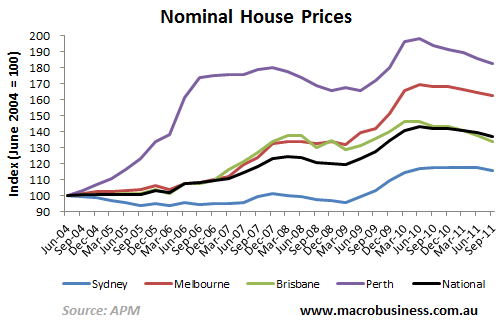
As you can see, nominal house prices are falling. Not collapsing, certainly. But falling very consistently, roughly 6% peak to trough. 8.5% in real terms. This has had a number of well documented effects including high savings rates, historically conservative levels of retail sales and stalled services sector investment.
Meanwhile, the boom sector of the economy, mining, is powering. Profits are flowing and the intentions to invest and build capacity are huge:
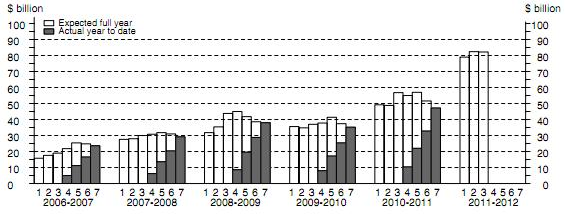
As we all know, the boom is the result of Chinese demand and record prices for our dirt. Here’s a chart of our August export income:
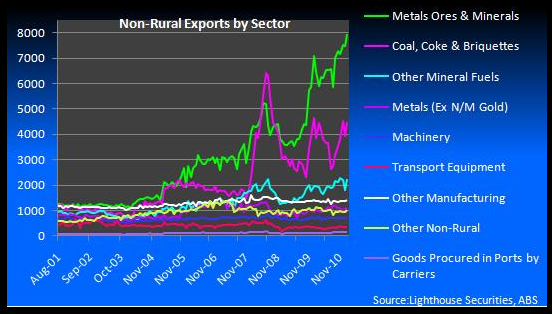
Here is the problem. As you can see, the income generated by the mining boom is heavily weighted towards just two commodities: iron ore and coal (green and pink lines). In fact, these two make up almost 50% of Australia’s terms of trade. And since the August peak, both commodities have been falling – a lot. Iron ore has dropped 35%, coking coal is down 21% and thermal coal about 10%. Here is the coking coal data I’ve been chasing for weeks, courtesy of the Coal Portal:
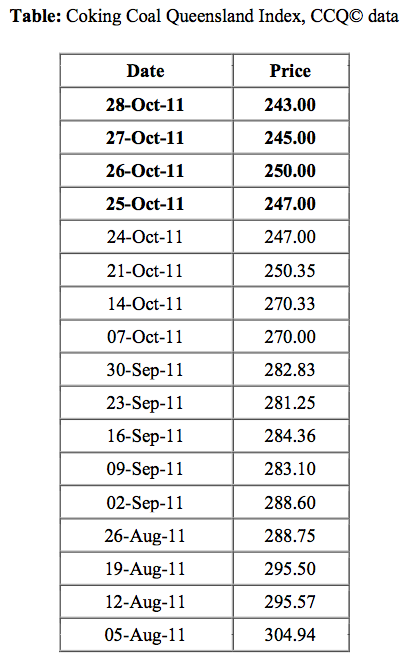
Now, in August, the latest month for which we have data, coal and iron ore earned Australia $12 billion in export income. Assuming the price falls we have seen get no worse (or better), by the time new prices filter through the various contract systems, those same commodities will earn us roughly $9 billion in January next year (all things being equal with the currency). The last time these two commodities earned that little was April 2010.
In sum, our circumstances are that we have a weak services economy driven by falling house prices, with a huge boom in an external sector driven by the terms of trade. The balance of these two effects has been to stall employment growth and, more recently, unemployment has begun to rise:
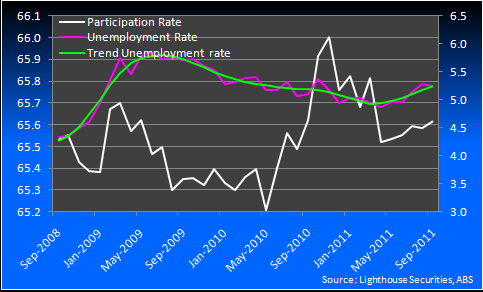
So what will the forthcoming drop in export income – a shock to the terms of trade – have on this mixed economy?
There is surprisingly little literature on the subject of terms of trade shocks. But a 2006 study conducted by the Australian Bureau of Statistics did model a very similar circumstance to the one we find ourselves approaching. It concluded:
When the domestic economy slows, but cash flows from a terms of trade effect are strong, businesses may be able to afford to retain staff they otherwise would have had to lay off. Businesses with a longer term outlook on market conditions may be able to maintain a stable rate of employment growth. In addition, for a given level of domestic output, the additional income induced by a rising terms of trade need not be distributed solely to shareholders (in the form of dividends) and to existing employees (as wages and salaries). It can also be retained for investment and / or hiring purposes. It is therefore not surprising to observe stronger than expected employment growth during periods of a strong terms of trade.
The growth rate (or business cycle) of GDP usually leads employment by around one to two quarters. However, this relationship can be distorted by various disturbances (or shocks) which impact upon the economy. Terms of trade shocks may alter the appearance of this relationship substantially. For example, if the economy has slowed but a terms of trade effect has prevented a similar slowdown in employment growth after the usual two quarters, then this lag will appear to be longer once the slowdown does occur. Alternatively, if forward-looking businesses maintain buoyant employment growth in anticipation of the next upswing in growth, then employment will appear to lead GDP once this upswing does eventuate.
What these two paragraphs describe is a kind of false economy that the high terms of trade presents to business. That is, the big income flows in the economy mask underlying production weakness that would usually result in job losses. When the terms of trade shock comes along, therefore, there is a relatively small impact on GDP but a quite high impact on unemployment.
Importantly, it also matters for what duration the terms of trade drop transpires. Obviously the shorter it is the less likely it is to expose the underlying economic weakness. At this stage the jury is out about the what kind of slowdown China can manage but a hard landing is a continuing risk. Even if there no dramatic slowdown per se, China is committed to slowing the fixed investment component of its economy (which drives iron ore and coking coal demand) so it is questionable that we’ll see a v-shaped recovery in our two key exports either way.
And remember that this shock will hit a services economy already shedding jobs and enduring falling asset prices. To my mind this risks a classic feedback loop in which unemployment begins to feed asset price falls and vice versa.
So, I vote for a rate cut tomorrow to boost confidence going into the New Year. To date, contrary to all of the bluster of the housing complex, the growth rate in lending for established dwellings hasn’t budged off its flat trend. There is no rush to invest in housing at all. If all of the above is wrong and the terms of trade quickly recovers there will be time to reverse the cut early next year if a renewed lid on housing is needed. Indeed, the RBA could frame its cut in just these terms, making it clear that it is offering short term support, depending upon the international outcome.
The bank should cut tomorrow.

